Thinking More Deeply About Habitat
April 5th, 2023 by Alex Zorach
When I created bplant, a lot of people asked me "Why are you creating yet another plant website, when there are already so many good ones out there?" My broad answer to this question is a greater focus on ecology. There are many specific answers as well, such as my original post about using ecoregions over political boundaries, and today I want to explore a different one: habitat.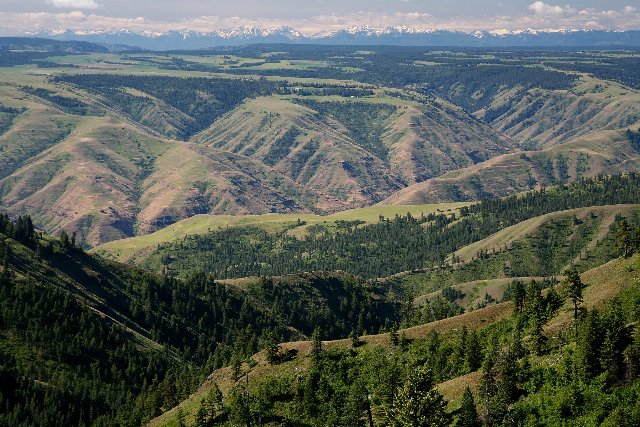 This photo shows the Blue Mountains in Oregon, where the vegetation cover varies significantly by elevation, slope aspect, and proximity to drainage, driven by changes in moisture availability. The West's more arid climate makes habitat differences more visible, whereas in the East, where deciduous forests cover most of the landscape, nuances in habitat are often glossed over. Photo © US Forest Service - Pacific Northwest Region, Public Domain, Source.
This photo shows the Blue Mountains in Oregon, where the vegetation cover varies significantly by elevation, slope aspect, and proximity to drainage, driven by changes in moisture availability. The West's more arid climate makes habitat differences more visible, whereas in the East, where deciduous forests cover most of the landscape, nuances in habitat are often glossed over. Photo © US Forest Service - Pacific Northwest Region, Public Domain, Source.In ecology, habitat is a broad term that refers to the environmental factors that allow a species to survive, thrive, and reproduce in a particular area. For plants, habitat encompasses climate, including both macroclimate (the climate of the broader region) and microclimate (details of temperature, moisture availability, and weather patterns particular to a local site), soil conditions (including both chemistry and texture), and the presence or absence of other organisms on the site. Plant habitat is directly influenced by factors such as topography or slope aspect, and hydrology, which includes the presence or absence of bodies of water, the depth of the water table, and the way water moves through the area.
This post can serve both as an introduction to the different aspects of habitat and preparation for what you will find in the habitat section of completed plant articles on our site, and as a reference on the different aspects of habitat.
Why is it important to understand plant habitat needs?
Matching a plant to the right habitat is critically important if you want plants to thrive. A plant growing in unsuitable conditions may struggle or die. Often, death occurs gradually, with a plant first becoming stressed and later succumbing to disease or insect infestation. Often, multiple factors interact, such as cold, flooding, or drought damaging a plant, followed by greater decline. A lot of gardeners wrongly blame disease, insects, or inclement weather for the death of their plants, however these causes are often secondary. Opportunistic infection or infestation can take advantage of stress caused by a plant growing in conditions it is poorly adapted to.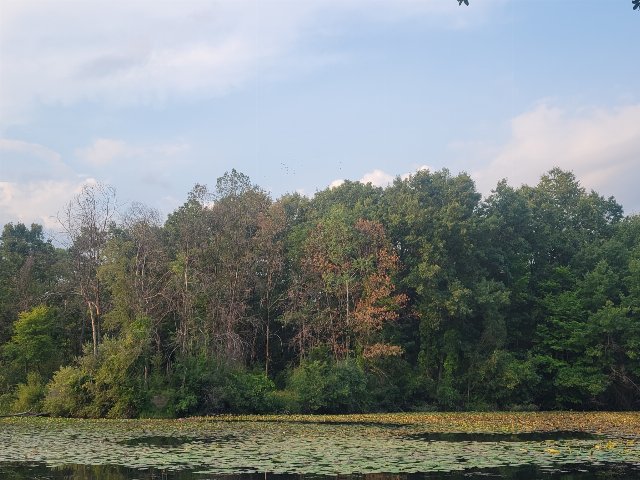 This photo shows a grove of northern red oak (Quercus rubra) that have succumbed to oak wilt (Bretziella fagacearum). Quercus rubra needs good drainage and grows optimally on mesic to slightly dry sites; this site is adjacent to a wetland, with a high water table and likely poor drainage, which may have been a factor in stressing these trees and leaving them vulnerable to disease. Photo © Dawn Hughes, CC BY 4.0, Source.
This photo shows a grove of northern red oak (Quercus rubra) that have succumbed to oak wilt (Bretziella fagacearum). Quercus rubra needs good drainage and grows optimally on mesic to slightly dry sites; this site is adjacent to a wetland, with a high water table and likely poor drainage, which may have been a factor in stressing these trees and leaving them vulnerable to disease. Photo © Dawn Hughes, CC BY 4.0, Source.Knowledge of habit preferences is also critical for protecting endangered species, because it can guide which habitats are most in need of conservation. It can also help locate new habitat when trying to increase the population of rare or endangered plants. This knowledge is especially important in today's world, especially in major metro areas where wild habitats are small and highly fragmented, and plants often need extra help from humans in transporting them into suitable habitats.
Limits of a Superficial View of Habitat
Prior to creating bplant.org, when researching plants for gardening or ecological restoration work, I found I was continually frustrated when looking up information plants and their growing conditions.Most gardening books and websites broke down plants' growing requirements into only two variables: moisture and light. Typically there were only three categories for each: moist, average, and dry, and full shade, part shade/sun, and full sun. Soil texture, nutrient levels, and other factors were mentioned only in passing, if at all. And more often than not, the sources repeated the same nearly-useless information on nearly all plants: "Best grown in moist, well-drained soil." Most plants can survive in moist, well-drained soil. But just because a plant survives there does not mean that it prefers or is most competetive in those conditions.
Many plants that gardening sources will advice you to plant in "moist, well-drained" conditions, actually are more competitive (and only found in the wild in) other, more adverse conditions. For example, although the red maple (Acer rubrum) will grow just about anywhere in landscaping, in the wild it is mostly found either in swamps or on dry, rocky ridges, rarely in mesic, i.e. "moist, well-drained" conditions.
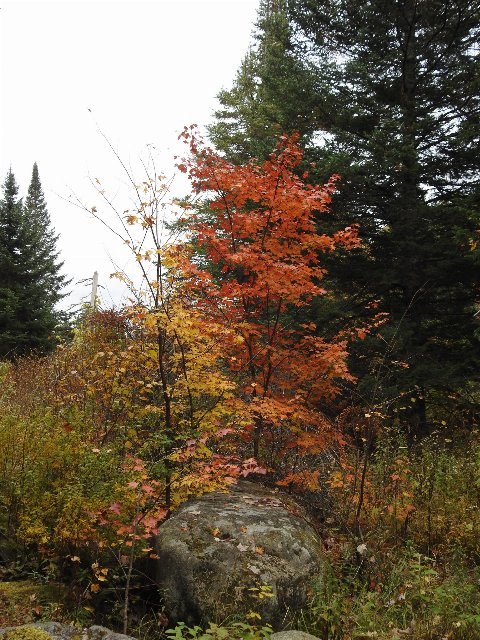 This red maple is growing amongst rocks in the floodplain of the Nulhegan river in Vermont. Although red maple is a generalist species, it is both tolerant of flooding, and rocky soils, giving it a competitive advantage on sites like this where other trees struggle. Note the absence of trees in the surroundings. Photo © Rachel Stringham, CC BY 4.0, Source.
This red maple is growing amongst rocks in the floodplain of the Nulhegan river in Vermont. Although red maple is a generalist species, it is both tolerant of flooding, and rocky soils, giving it a competitive advantage on sites like this where other trees struggle. Note the absence of trees in the surroundings. Photo © Rachel Stringham, CC BY 4.0, Source.I found myself frequently confronted with a list of 20 or more different plants which were all described as liking the same sun and moisture conditions. Yet when I looked in the wild, I would see some of these plants thriving on a particular site, and not others. Sometimes I would even try to grow a plant, only to find it fared poorly, whereas on other sites it would be vigorous, even aggressive. I found myself continually asking: "Why?" and this question led me to examine the less obvious aspects of habitat. And as I did, I became better at growing plants, both in my garden and in ecological restoration projects.
And if you want to do ecological restoration work, whether in the wild, or using your own garden or yard as a semi-wild habitat, you need to look more deeply too. You need to treat plants not as an aesthetic decoration, but as part of an ecosystem, with unique adaptations, needs, and strengths and weaknesses.
Important (and Often-Neglected) Aspects of Plant Habitat
As gardening sources suggest, moisture and light availability are often (not always) two of the most important factors in determining whether not a particular plant will grow on a particular site. However, there are many others, and part of the purpose of bplant is to draw attention to these other factors:- Soil texture
- Soil nutrients
- Soil pH / acidity
- Drainage
- Microclimate
- Disturbance regime
- Presence or absence of other organisms
Soil Texture
Soil texture is one of the most important aspects of soil because it influences drainage, moisture availability, and the possible root structures a plant can develop. A simple way of looking at soil texture is as a continuum of particle sizes:rock > gravel > sand > silt > clay
Most soils are not uniform, but contain a mix of particles of different sizes. Because the smaller particles determine water percolation and drainage, usually when considering soil texture, people pay most attention to the ratios of sand, silt, and clay in a soil. A common term you will encounter is loam. Loam is not a particle size so much as a range of mixtures of particles that describes a "middle" or "ideal" soil texture that balances drainage, water retention, air circulation, and nutrient availability. Usually, loamy soils are well-developed soils that have been created by biological processes, balancing organic matter with mineral content and air pockets.
 This diagram from the USDA illustrates the portions of sand, silt, and clay particles in the various terms for soil texture. As you can see, there is an asymmetry in that clay particles influence soil texture more than sand or silt, and silt does somewhat more than clay. Loam has less clay than silt, and slightly less silt than sand. In general, the farther from "loam" soil is in this diagram, the more adverse the soil conditions are for plants, although there are plants that prefer all textures in this diagram. Photo © cmglee, Mikenorton, United States Department of Agriculture, CC BY-SA 4.0, Source.
This diagram from the USDA illustrates the portions of sand, silt, and clay particles in the various terms for soil texture. As you can see, there is an asymmetry in that clay particles influence soil texture more than sand or silt, and silt does somewhat more than clay. Loam has less clay than silt, and slightly less silt than sand. In general, the farther from "loam" soil is in this diagram, the more adverse the soil conditions are for plants, although there are plants that prefer all textures in this diagram. Photo © cmglee, Mikenorton, United States Department of Agriculture, CC BY-SA 4.0, Source.Soils very high in organic matter and low in mineral content have different texture-related terms. Muck refers to a fine-textured, waterlogged organic soil in which the original organic matter is so broken down that it is unrecognizable. Muck is common in wetlands with poor drainage and low mineral content. Peat, on the other hand, is similarly predominately-organic soil that is a bit less broken down, coarser and more spongy in texture. A related term is humus, which refers to the fine-textured dark organic matter in any soil.
Soil texture is often different at different layers, too. Typically, the surface layers of soil are more weathered than deeper layers, and the depth to reach bedrock through soil can range from essentially zero in a rock outcropping, to hundreds of feet deep, completely outside the reach of plant roots. Sometimes a fragipan, an impermeable or slowly-permeable layer of clay, underlies coarser-textured soil. All of these factors affect plant growth, and many plants specialize in soil with one texture at the surface and another deeper down.
Soil Nutrients
Plants require a variety of nutrients in a particular balance, and typically, different nutrients will be limiting in different ecosystems. However, different plants have different nutrient needs, and some are thus better-adapted than others to survive on a particular site.Nitrogen is a key nutrient for plants, and a key component of proteins, which are the building-blocks of all living organisms. The atmosphere provides an essentially endless supply of nitrogen, but in a form unavailable to most plants. Certain plants, called nitrogen-fixers, have a symbiotic relationship to bacteria, typically in root nodules, which convert atmospheric nitrogen to a form plants can use. Nitrogen-fixing plants have a major advantage in nitrogen-poor soils, and will not only grow faster than other plants in these environments, but in the long-run they will also boost the growth of surrounding plants as they shed nitrogen-rich litter and release nitrogen through their roots. Nitrogen tends not to be limiting in the long-term in undisturbed ecosystems, but it can be limited on eroded or exposed mineral soils, or following a fire or the clearing of land by humans.
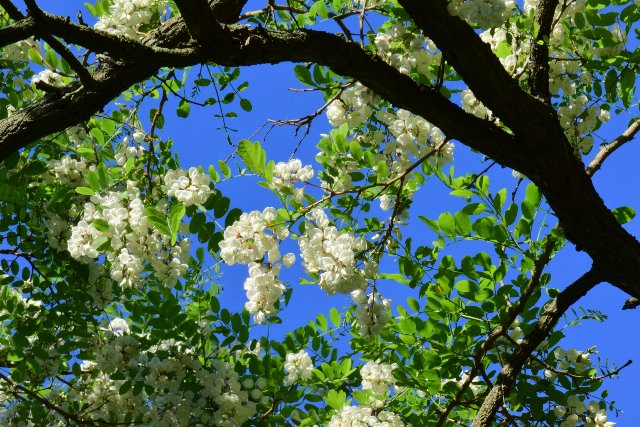 Black locust (Robinia pseudoacacia) is an example of a nitrogen-fixer, thriving in nitrogen-poor environments, but rapidly transforming them into nitrogen-rich environments and thus eventually leading to its own elimination. Photo © Bernie Paquette, CC BY 4.0, Source.
Black locust (Robinia pseudoacacia) is an example of a nitrogen-fixer, thriving in nitrogen-poor environments, but rapidly transforming them into nitrogen-rich environments and thus eventually leading to its own elimination. Photo © Bernie Paquette, CC BY 4.0, Source.Phosphorus is another key nutrient for plants. Phosphorus in ecosystems originates in rocks and minerals and tends to be released as rocks are weathered, but the phosphorus content of different rocks, and thus different soils, varies widely. As such, plants have widely different adaptations to high or low levels of phosphorus. Plants in low phosphorus environments tend to have more surface roots and more total roots relative to shoots. Because the processes that release phosphorus into bioavailable forms are slow, phosphorus tends to be a limiting factor in the growth of most ecosystems in the long-run. High-phosphorus ecosystems tend to develop denser, richer canopies and contain more shade-tolerant species, relative to phosphorus-poor systems, when other factors are not limiting.
Calcium is a key nutrient for plants not only because it is directly used by plants, but because it is an important buffer that affects soil pH. Soils or rocks rich in calcium are called calcareous; the most common calcareous soils are those derived from limestone, dolomite, or marble (which is metamorphosed limestone.) Poorly-developed rocky soils on calcareous rocks tend to have a high pH that limits plant growth, whereas well-developed calcareous soils tend to have a neutral pH. Calcium tends to form slightly-soluble compounds, and thus leaches from soil faster than metals like iron or aluminum, but slower than magnesium, sodium, or potassium. Thus, arid and semiarid regions tend to have more calcium in the soil and higher pH regions, whereas regions with high rainfall tend to have low calcium and more acidic soils. The presence of calcium in soil often allows plants to move into slightly drier conditions than they would prefer in lower-calcium soils, which relates to plants utilizing calcium as a way of protecting themselves from drought stress.
Magnesium is another essential nutrient with a similar buffering effect to calcium, tending to raise the pH. It is also an essential ingredient in chlorophyll, the chemical plants use to capture energy from sunlight. Magnesium tends to leach more readily than calcium, and like with calcium, it tends to be leached more in areas of high rainfall. Soils derived from dolomite tend to be highest in magnesium, whereas any acidic soils tend to be deficient in it.
Together, soils high in the total of calcium and magnesium are called base-rich soils.
Other ingredients can, under less common circumstances, be limiting in plant growth as well. Potassium is probably the most important essential nutrient not mentioned above; it is abundant in most plant growth and litter, including ash from burned plants, but it can occasionally be deficient in some soils. Iron is essential for plant growth but is usually abundant in soils. Under certain rare circumstances, soils can be deficient in manganese, copper, zinc, or molybdenum.
Unlike animals, sodium is not essential for most plant growth. However, some plants can utilize it to a degree, and it is an important factor inhibiting plant growth in some ecosystems. Because sodium and its salts are highly soluble, the salinity of water and/or soil is only an issue for plants either along coasts, including along coastal estuaries, and in endorheic basins, basins in the center of the continent that do not drain to the ocean. Saline soils are thus a major factor limiting plant growth in arid regions of the West.
Soils can also contain other toxic elements that inhibit plant growth, such as chromium, cobalt, and nickel. This phenomenon occurs naturally in soils derived from serpentine minerals, creating an environment called serpentine barrens. However, it can also occur on polluted sites, such as former industrial sites, mine spoils, and other brownfields.
Soil pH or Acidity
Acidity is one of the most important aspects of soil chemistry, as it interacts with all the nutrients above and it tends to be a single dimension that captures and relates to the presence and availability of many different nutrients. pH is the most widely-used measure of acidity.Neutral pH is 7, the pH of water. Higher pH is basic, whereas lower pH is acidic. Although there are exceptions to both trends, organic matter tends to be more acidic, whereas mineral-nutrients often tend to contribute to higher pH. Soils tend to range between about 3.3 at the most acidic, to 10 at the most basic.
Plants tend to grow most vigorously in neutral to slightly acidic soil, ranging from 6.0 to 7.0. Soils derived from calcareous rocks tend to stay above 5.5, but soils poor in calcium and magnesium often become much more acidic. The most acidic soils tend to be found in bogs, which tend to range from 3.3-5.5. In humid climates, acidic soils are also found under boreal forests, in coarse sandy barrens, and on rocky soils derived from calcium-poor rocks such as sandstone, quartzite, or granite.
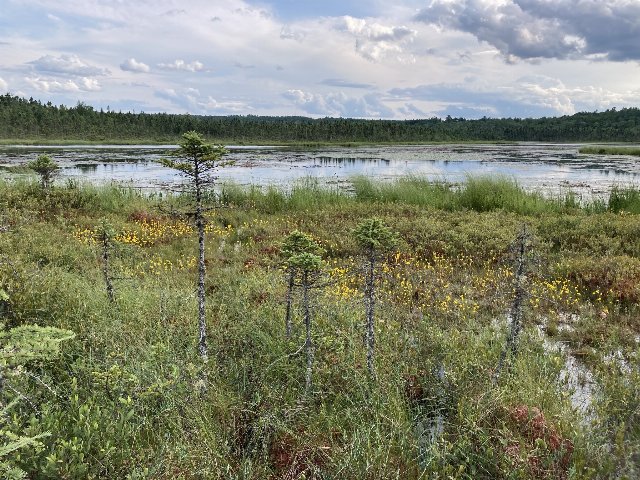 Bogs are some of the most acidic habitats there are and support vegetation specialized on low-pH soils and poor drainage, like the black spruce (Picea mariana) in this picture, which, although stunted, is also the largest woody vegetation growing in this bog. Photo © er-birds, CC BY 4.0, Source.
Bogs are some of the most acidic habitats there are and support vegetation specialized on low-pH soils and poor drainage, like the black spruce (Picea mariana) in this picture, which, although stunted, is also the largest woody vegetation growing in this bog. Photo © er-birds, CC BY 4.0, Source.Soil pH is directly related to climate, with rainfall being the biggest factor and temperature also being important. Because rainfall tends to leach calcium and magnesium from soil, minerals which contribute to higher soil pH, higher rainfall tends to create more acidic conditions and lower soil pH, whereas drier regions tend to have higher soil pH. Because warmer climates speed plant growth and the accumulation of organic matter, warmer temperatures also tend to further decrease soil pH in areas already sufficiently moist or humid. However, this effect is insignificant in arid areas because there is little plant growth, so hot arid regions tend to still have high pH soils.
Also, in climates that get cold enough to be dominated by evergreen conifers, such as the Northern (Boreal) Forests, Marine West Coast Forest, and the higher elevations of the Western Cordillera, the cold temperatures lead to slower breakdown of organic matter and slower weathering of rocks, which also contributes to acidic soils.
In arid regions with varied topography, three factors lead higher elevations to have more acidic soil and low elevations higher soil pH: higher elevations tend to have higher rainfall, mountains often have conifer-dominated forests that drop acidic litter, and water tends to transport the water-soluble calcium and magnesium downhill.
Preferences for soil pH explains the distributions of many plant species. For example, many plants that prefer higher ph soils, such as bur oak (Quercus macrocarpa), are absent from the southeast, but have ranges that extend quite far south in the great plains, into central Texas, where the semiarid climate leads calcium to be more conserved in the soil, and also range farther east into humid climates in the northeast and upper midwest, where cold temperatures also conserve calcium. At the other end of the soil pH preference spectrum, chestnut oak (Quercus montana) prefers acidic soils, and as such its range stops at the part of Ohio that consistently has calcium-rich soils, whereas on the east coast, it ventures well into coastal habitats such as the Pine Barrens of Long Island and New Jersey.
Drainage
Soil and site drainage is one of the most important aspects of a plant's habitat, as it influences both water availability and soil aeration. Some people do not realize that plants actually need air as well as water, and receive air through their roots. Although some aquatic or partially aquatic plants have special adaptations that help them capture air in their above-water parts and use it to supply underwater parts, most plants rely on their root system for capturing air. As such, soil aeration is essential for most plants.Soil drainage can be divided into classes with self-explanatory names: "excessively drained", "somewhat excessively drained", "well drained", "moderately well drained", "somewhat poorly drained", "poorly drained", and "very poorly drained". Although going deep into the definitions and implications of these different categories is beyond the scope of this post, it can be helpful to understand some of the basic ideas of the different levels of drainage.
Excessively drained soils are such that water is drained so rapidly that there is almost no retention in the soil. Typically this occurs when soils consist mostly of coarse sands, but it can also occur on thin soils over impermeable bedrock that causes water to run off. Excessively drained soils create drought- and fire-prone habitats even in areas with high rainfall. Examples of such habitats include the New Jersey Pine Barrens or the Newaygo Barrens in the western portion of Michigan's Lower Peninsula. Regions with excessively drained sands have some unusual phenomena, like deep water tables with levels remaining nearly constant year-round, and rivers and streams that never freeze, even in surprisingly cold climates, like portions of the Muskegon River in Michigan. All of these factors create unique habitats for distinctive plant communities. Excessively-drained sands typically are found on a site with a history of water depositing them at some point in the past, such as sand dunes of past ocean or lake shorelines, or glacial outwash fields.
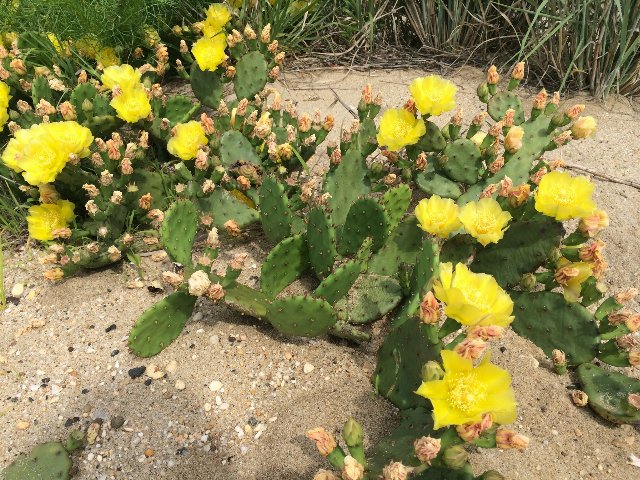 Excessive drainage can create drought-prone habitats even in climates with consistently high rainfall. Some species, such as this eastern prickly pear (Opuntia humifusa), specialize in these habitats; this one is growing in coastal sands at Sandy Hook, NJ, but this species also can be found well inland in excessively-drained soils of other origins. Photo © Bonnie Semmling, CC BY 4.0, Source.
Excessive drainage can create drought-prone habitats even in climates with consistently high rainfall. Some species, such as this eastern prickly pear (Opuntia humifusa), specialize in these habitats; this one is growing in coastal sands at Sandy Hook, NJ, but this species also can be found well inland in excessively-drained soils of other origins. Photo © Bonnie Semmling, CC BY 4.0, Source.Well-drained soils tend to strike a balanced between availability of moisture and aeration and tend not to produce any stress from lack of soil aeration, while they retain enough moisture to provide plants with adequate moisture except during periods of prolonged drought. Discussed above in the soil texture section, loam is usually well-drained or close to it.
Poorly-drained soil drains so slowly that the soil tends to stay wet at shallow depths after it rains. However, is important to note that wet is not the same as moist. Wet, which can also be termed "waterlogged", means that the soil is so saturated with water that there are few or no air bubbles left in the soil. Moist soil, on the other hand, has ample water availability but still has air pockets in it. Wet soil creates stress on most plants whereas moist soil typically does not. In most regions, poor drainage is defined as soils in which water percolates more slowly than 1 inch per hour.
It is also important to understand that, while wetlands and other sites with a high water table are often poorly-drained, poorly-drained soils or habitats are not necessarily moist. A small depression in an upland habitat, with clay soil, exposed to full sun, will likely be poorly drained and may remain waterlogged for hours or days, yet may also become completely dry after just a few days without rain, and plants there may experience significant drought stress. Small depressions in impermeable bedrock, such as a depression in a granite rock outcropping, are an even more extreme example of a habitat which is poorly drained but prone to being extremely dry most of the time. An ecoregion rich in habitats that are both dry and poorly-drained is the Blackland Prairie of Mississippi and Alabama, but many other regions have at least some isolated sites with these properties.
Microclimate
Microclimate represents the ways in which climate or weather varies on a particular site, relative to the average or typical climate of the broader region. Terrain is one of the biggest influences on microclimate. Ridgetops and peaks often have higher winds, greater temperature extremes, and receive more total sunlight relative to valleys. The steeper the slope, the bigger its influence on microclimate.Slope aspect refers to the direction a slope faces. In the northern hemisphere, south-facing slopes receive more sunlight and thus tend to be warmer and drier whereas north-facing slopes receive less sun and tend to be cooler and moister. Because the sun rises in the east and sets in the west, and the air tends to heat up and clouds tend to burn off throughout the day, west-facing slopes are similarly sunnier, warmer, and drier than east-facing slopes. So, ecologically, the main microclimate division in hilly terrain tends to be between warmer south- and west-facing slopes and cooler north and east-facing slopes.
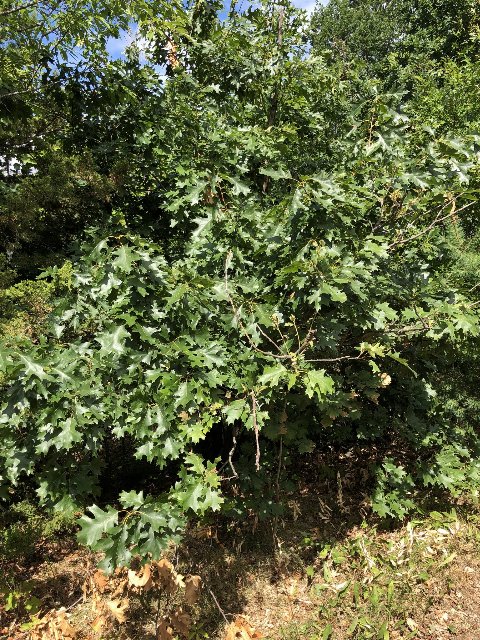 This black oak (Quercus velutina), growing at Crowninshield Island, Massachussets, is growing on a south-to-southwest facing slope, which creates an ideal microclimate for this species, which is otherwise near the northern limits of its range here. Photo © Sus scrofa, CC BY 4.0, Source.
This black oak (Quercus velutina), growing at Crowninshield Island, Massachussets, is growing on a south-to-southwest facing slope, which creates an ideal microclimate for this species, which is otherwise near the northern limits of its range here. Photo © Sus scrofa, CC BY 4.0, Source.Bodies of water, especially larger ones, tend to modify microclimate. One obvious effect is increasing the humidity of nearby air, but water also has a moderating effect on temperature. Because of its high specific heat relative to air or rock, water stores a great deal of heat and tends to warm or cool slowly. This effect becomes diminished somewhat in winter in areas where the bodies of water completely freeze over. At the same time, a large, open body of water creates space for high winds. Larger bodies of water, such as oceans or the Great Lakes, can also create lake effect precipitation downwind from them, especially when hills or other elevation gains are downwind from the water.
Human modifications to the environment also influence microclimate. Buildings create environments mimicking the effects of slope aspect but often being more severe due to the 90-degree angle buildings make with flat ground, creating very hot, dry south faces and cool, shady north faces. The heat from buildings also leaches into the environment, warming the surroundings at all times of year. On a larger scale, this effect, combined with the clearing of vegetation, produces the urban heat island effect which not only raises temperatures but also increases rainfall downwind from cities. Construction can also alter drainage and create both wet and dry microclimates, as well as both wind tunnels and sites sheltered from wind.
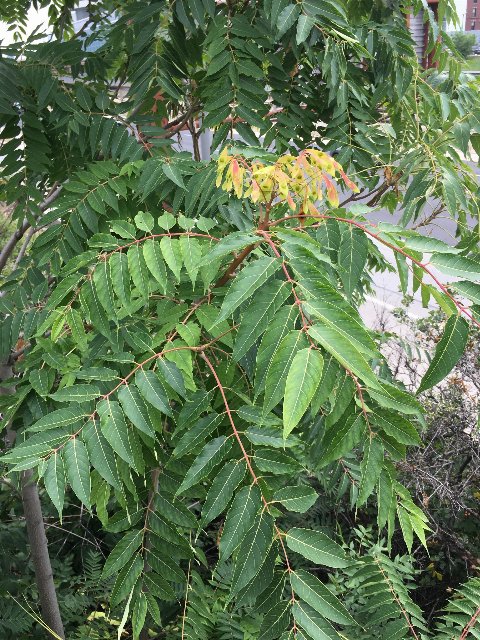 Tree of heaven (Ailanthus altissima), invasive in North America, is able to survive in urban areas at the northern limits of its range due to urban heat island effect. This tree is growing in Chicago's Near West Side. Photo © John Dziak, Public Domain, Source.
Tree of heaven (Ailanthus altissima), invasive in North America, is able to survive in urban areas at the northern limits of its range due to urban heat island effect. This tree is growing in Chicago's Near West Side. Photo © John Dziak, Public Domain, Source.Microclimate is a major factor driving plant ranges as well as plant habitat around the edges of their ranges. For example, the eastern white pine (Pinus strobus) is mostly restricted to cooler north-facing slopes in the south of its range. And most oaks, in the north of their range, are restricted to warmer south-facing slopes. The absence of varied topography also explains why many tree species that are common in eastern and southeastern Ohio, as well as Michigan, but near the borders of their range in both of these regions, become uncommon or are even absent entirely, from northwest Ohio and bordering parts of Indiana: these areas are so flat that there is a lack of warmer or cooler microclimates, so the only trees that thrive are ones solidly within their climate tolerances. Hilly topography thus supports plants with a broader range of climate tolerances.
Microclimate is also a major factor in plants that can survive in urban areas but not in adjacent wild areas. In cities, urban heat island effect, along with huge variations in temperature and moisture availability create a variety of ecological niches that do not exist in the broader region. Because cities tend to have more hotter, drier, and more open habitats, many western species adapted to deserts or the drier portions of the Great Plains have expanded eastward but only or primarily occur in cities in these regions. Many plant also thrive along roadsides and railroads for similar reasons of higher sunlight and drier conditions created by the well-drained roadbeds or railroad beds.
Disturbance Regime
Habitats are not static; they change both due to natural and human-induced disturbances. A disturbance can be seen as any event that kills or removes some part of an ecosystem, opening up space or exposing a particular area to greater sunlight. Disturbances can also have wildly different scales. Small-scale natural disturbances can include individual plants dying, a tree losing a large limb, animals digging holes or eating a particular plant, or a small area of soil slumping down a hill or eroding from a streambank. Medium-scale disturbances can include windthrow of a large tree or a few trees, frost heaving in cold climates, larger rockslides, a brief flood of a small stream, or a permanent flood caused by beavers building a dam. Large-scale disturbances can include wildfires, drought, hurricanes, large tornado outbreaks, large-scale flooding, or a volcanic eruption. Insect outbreaks can also cause disturbances of virtually any scale.Humans induce disturbances of all scales too, from a person uprooting or cutting down a small plant, trampling an area, to regular mowing or weedwhacking of an area, controlled burning, spraying of herbicides, or something large-scale such as logging, strip mining, or clearing of land or alteration of the hydrology by channelizing or damming rivers and flooding large areas.
 This unusual-looking root structure is common on yellow birch (Betula alleghaniensis); it usually originates when a tree germinates and establishes on a stump of a dead tree, grows roots to the ground, and the stump later rots. Yellow birch is a gap-specialist, relying on small-scale disturbances in forests of shade-tolerant trees, such as that created by a single tree dying. Photo © David McCorquodale, CC BY 4.0, Source.
This unusual-looking root structure is common on yellow birch (Betula alleghaniensis); it usually originates when a tree germinates and establishes on a stump of a dead tree, grows roots to the ground, and the stump later rots. Yellow birch is a gap-specialist, relying on small-scale disturbances in forests of shade-tolerant trees, such as that created by a single tree dying. Photo © David McCorquodale, CC BY 4.0, Source.Disturbance isn't inherently good or bad, and different plants are adapted to different levels or types of disturbance. Many plants rely on specific types of disturbance in order to establish: for instance, yellow birch (Betula alleghaniensis) colonizes gaps in forests of sugar maple (Acer saccharum) and American beech (Fagus grandifolia). The presence of gaps caused by dead trees allows the yellow birch to persist in forests dominated by two more shade-tolerant species that it would not otherwise be able to compete with. In this example, the sugar maple and beech are better-adapted in the scenario of no disturbance, able to reproduce under the shade of a closed forest canopy. However these species also differ in their ability to colonize sites subjected to a large-scale disturbance: the sugar maple is also an early colonizer of completely cleared sites, whereas American beech is not, and only moves into a forest once other mature trees are already present.
A more extreme example is longleaf pine (Pinus palustris), which relies on frequent severe fire to reproduce and survive, and will be eliminated not only on sites that do not burn, but on sites that experience too mild or too infrequent fire.
Many small plants with short lifecycles also rely on disturbance. Most garden weeds, such as purple deadnettle (Lamium purpureum), are disturbance-loving plants, and they thrive in gardens specifically because humans expend so much energy cutting and clearing away vegetation. Understanding disturbance regimes that various plants prefer is critically important for gardening efficiently and sustainably, and can also be critical in ecological restoration work, especially when it comes to control of invasive plants. A lot of attempts to control invasive plants fail or even backfire because the plants actively benefit from the sort of disturbance, such as mowing or herbicide, that people use to try to control them.
Presence or Absence of Other Organisms
The presence of any organism alters a habitat in ways that can either increase or reduce the suitability of the site for a particular plant. This is true of all organism types, including animals, fungi, microorganisms, and other plants.A common example of this sort of effect is browsing by herbivores, which in the eastern U.S. is most likely to be white-tailed deer. Very different plants will thrive on plants where deer are present vs. absent, and the degree of browsing is also a factor, with different plants thriving in areas with deer overpopulation and severe browsing pressure, vs. only light browsing pressure. Besides wild animals, livestock also exerts browsing pressure on plants. This pressure is severe in pastures where the livestock is kept for long periods, and significantly less in open rangeland where livestock might only be brought through for a brief period of time.
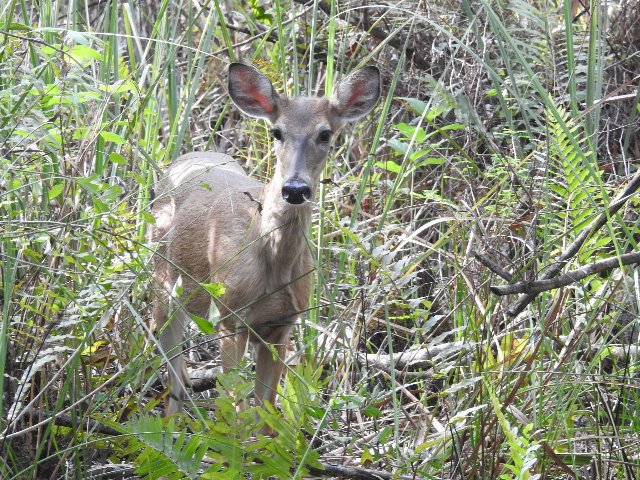 White-tailed deer (Odocoileus virginianus) exert strong pressure on plants through their browsing, especially where they have become overpopulated due to humans eliminating their predators, combined with the expansion of low-density suburban areas and the exclusion of hunting in these residential areas. Photo © Rachel Stringham, CC BY 4.0, Source.
White-tailed deer (Odocoileus virginianus) exert strong pressure on plants through their browsing, especially where they have become overpopulated due to humans eliminating their predators, combined with the expansion of low-density suburban areas and the exclusion of hunting in these residential areas. Photo © Rachel Stringham, CC BY 4.0, Source.Plants directly improve or reduce the suitability of habitat for other plants. One of the most important ways plants influence a habitat is shading, which creates selection pressure for shade-tolerant plants. Plants also compete with each other for water and nutrients, which can create pressure for efficient, nutrient-conserving plants as an ecosystem matures. In some cases, plants can be parasitic or hemiparasitic. The most well-known parasitic plant here is the native indianpipe (Monotropa uniflora). There are also obligate hemiparasites, which photosynthesize but also steal resources from their host, such as mistletoes (Phoradendron sp. being our native species) which attach to trees, or false foxgloves (Agalinis sp.) which are facultative hemiparasites, attaching to the root systems of their hosts. Obligate parasites or hemiparasites require the presence of certain hosts in their environment, whereas facultative ones merely prefer or benefit from their presence but can survive without them.
The influence or alterations of plants on a habitat can be much more involved than the above examples. Many plants are allelopathic, meaning that they secrete chemicals that inhibit the growth of other plants, and the allelopathy is usually selective, with certain plants being better-adapted to the presence of certain chemicals than others. Allelopathy is a major factor in both the success of certain invasive plants and the damage they cause to ecosystems. Garlic mustard (Alliaria petiolata) is one of the best-known invasive plants that alters habitats through its allelopathy. Garlic mustard has both direct effects on other plants, and indirect effects through inhibiting the growth of soil fungi. However, native plants can also be allelopathic; for example some goldenrods (Solidago sp.) are allelopathic and tend to slow the establishment of trees that would shade them out.
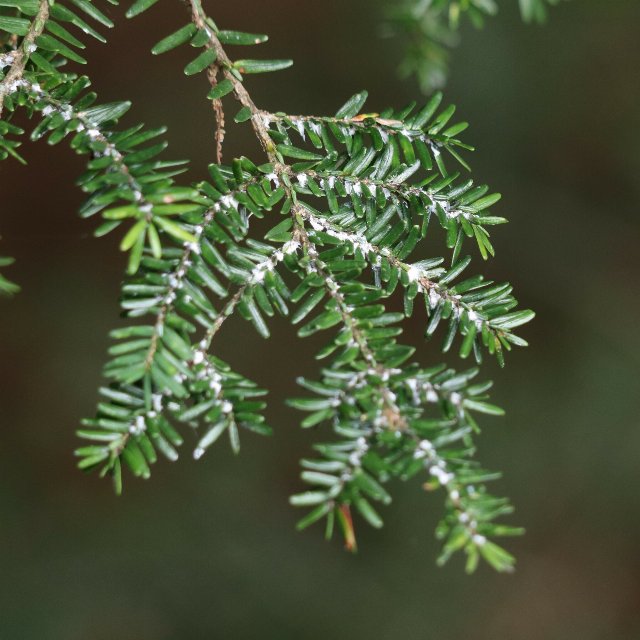 The hemlock wooly adelgid (Adelges tsugae) has stressed eastern hemlock (Tsuga canadensis) trees throughout their range, eliminating them from more marginal habitats and causing them to struggle in habitats where they once thrived. Photo © Mark Apgar, CC BY 4.0, Source.
The hemlock wooly adelgid (Adelges tsugae) has stressed eastern hemlock (Tsuga canadensis) trees throughout their range, eliminating them from more marginal habitats and causing them to struggle in habitats where they once thrived. Photo © Mark Apgar, CC BY 4.0, Source.The introduction of pests and pathogens interacts with other habitat factors, often narrowing the range of conditions in which a plant can survive, and in some cases making whole parts of a plant's range unsuitable for it. For example, the hemlock wooly adelgid was introduced to Eastern North America, and threatens the native hemlocks here. However, it tends to hit hemlocks hardest when they are already more stressed by sun or drought. As such, this pest has eliminated eastern hemlock (Tsuga canadensis) from much of the southernmost reaches of its range, even in areas where the plant is able to survive if the adelgid is kept away (such as by chemical treatments.) In more extreme cases, species can be nearly-completely eliminated by a pathogen or insect, such as the American chestnut (Castanea dentata) being almost completely removed from eastern forests by the chestnut blight. Currently, ashes (Fraxinus sp.) are facing severe die-back due to the emerald ash borer, an introduced insect.
Mycorrhizal fungi are also an important factor in the survival of many plants. The fungal network often drives the availability of nutrients and even energy in an ecosystem, and is poorly understood and often ignored, in part because it is hard to directly observe.
The Habitat Section in Plant Articles
If all of these factors seem like a lot, there is no need to feel overwhelmed. This post is intended primarily to expose people to the diversity of habitat factors; the hope is that people will better understand and remember to consider these factors if they've been exposed to them at least once.For a particular plant, however, there are usually a more manageable number of factors that you need to consider when studying or learning about its habitat preferences and needs, and most factors can be ignored. For example, in much of its range, Canada wildrye (Elymus canadensis) will grow in virtually any soil type or texture, and merely needs sun and recent disturbance to establish. Or the common hackberry (Celtis occidentalis) will grow in a wide range of soil textures and moisture and lighting conditions, but requires soil with a high calcium content and not too low pH.
The Habitat section of each plant article, which you can access in one click from the purple table-of-contents at the top of each article, when completed, collects the most important aspects of a particular plant's habitat preferences in one place.
In some cases, there are also a lot of unknowns or open questions. Even for our completed articles, the habitat section is often an ongoing project. If you notice anything interesting about a plant's occurence or absence in particular habitats and have something to contribute, please get in touch with us.
You can also learn a lot by observing plants in nature. There is often a disconnect between what is written in official sources, and what you directly observe in the wild. Part of this is the inherent limitations of human knowledge, but part of it is that plants and ecosystems themselves are dynamic. As climate changes, and as plant populations evolve and adapt to new conditions, and as the other organisms present in ecosystems change, the habitat preferences of various plants will also change. There is thus a continuous need for observation, and questioning and updating of accepted knowledge. When in doubt, treat any information about plant habitat as a working hypothesis, not as established fact, and this goes not only for the material you read on our site, but for any source. Go out into nature and observe plants in the wild: this is ultimately the only way to get an accurate picture of what plants' habitat preferences actually are. In doing so, you may end up contributing to an increased understanding of these plants!
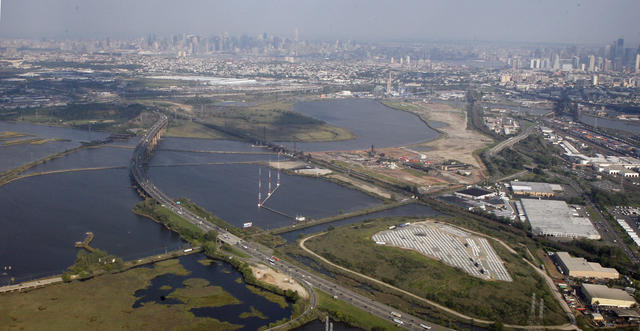 This picture of the Hackensack Meadowlands, a region outside NYC once featuring biodiverse wetlands, illustrates a scene typical of major metro areas: development and industry has reduced the wild areas to a tiny portion of their original extent, and degraded them in multiple ways. Greater understanding of the importance of habitat will create greater will to restore and protect these rare and threatened habitats. Photo © Doc Searls, CC BY 2.0, Source.
This picture of the Hackensack Meadowlands, a region outside NYC once featuring biodiverse wetlands, illustrates a scene typical of major metro areas: development and industry has reduced the wild areas to a tiny portion of their original extent, and degraded them in multiple ways. Greater understanding of the importance of habitat will create greater will to restore and protect these rare and threatened habitats. Photo © Doc Searls, CC BY 2.0, Source.I also hope that, as people come to understand the richness of the factors that go into plants' unique adaptations to diverse habitats, people will ultimately see the value of and need to restore and protect wild habitats, as well as the ways in which we can make the land actively used by humans be better habitat for plants and the other organisms that depend on them.
Archive of All Blogs
The Bias Against Tall Plants, November 11th, 2025
A Focus on Goldenrods (Solidago sp.), July 23rd, 2025
Disturbance and its Role in Plant Habitat Preferences, May 29th, 2025
What "Native" or "Introduced" Mean: Myths and Misconceptions, March 11th, 2025
Smarter & More Informative Search Results, January 13th, 2025
The Effect of the 2024 US Election on Plant Biodiversity and bplant.org, October 30th, 2024
The Problems With Nursery-Bought Plants, And The Solutions, October 8th, 2024
More Databases Linked & Search Improvements for Scientific Names, July 9th, 2024
Choosing The Best Common Names For Plants: Challenges & Solutions, April 19th, 2024
Range Map & Taxonomic Update Progress, January 31st, 2024
Giving Thanks To Everyone We Rely On, November 22nd, 2023
Thinking More Deeply About Habitat, April 5th, 2023
2022 Year-End Summary: Successes & New Goals, February 15th, 2023
New Databases Linked: Flora of North America & NatureServe Explorer, November 11th, 2022
All Range Maps 2nd Generation, Taxonomic Updates, & Fundraising Goal Met!, September 29th, 2022
More Range Map Improvements, POWO Interlinking, And Notes Fields, June 7th, 2022
Ecoregion-Based Plant Lists and Search, March 30th, 2022
Progress Updates on Range Maps and More, February 10th, 2022
The Vision for bplant.org, December 9th, 2021
New Server: Software & Hardware, August 30th, 2021
More & Improved Plant Range Maps, July 19th, 2021
A Control Section for Invasive Plants, April 15th, 2021
Progress Bars & State Ecoregion Legends, March 11th, 2021
Our 2020 Achievements, February 9th, 2021
Interlinking Databases for Plant Research, November 11th, 2020
A New Homepage, Highlighting Our Articles, July 29th, 2020
A False Recovery, But North Carolina's Ecoregions are Complete!, June 9th, 2020
We're Back After COVID-19 Setbacks, April 3rd, 2020
Help Us Find Ecoregion Photos, February 27th, 2020
What We Achieved in 2019, December 30th, 2019
Plant Comparison and ID Guides, October 30th, 2019
We Are Now Accepting Donations, October 14th, 2019
US State Ecoregion Maps, New Footer, Ecoregion Article Progress, and References, September 19th, 2019
Tentative Range Maps of Native Plants, August 12th, 2019
Ecoregion Locator and Interactive Maps, July 10th, 2019
Using Ecoregions Over Political Boundaries, May 13th, 2019
How We Handle Wild vs Cultivated Plants, April 16th, 2019
A Blog To Keep People Updated On Our Progress, April 8th, 2019
Sign Up
Want to get notified of our progress? Sign up for the bplant.org interest list!


